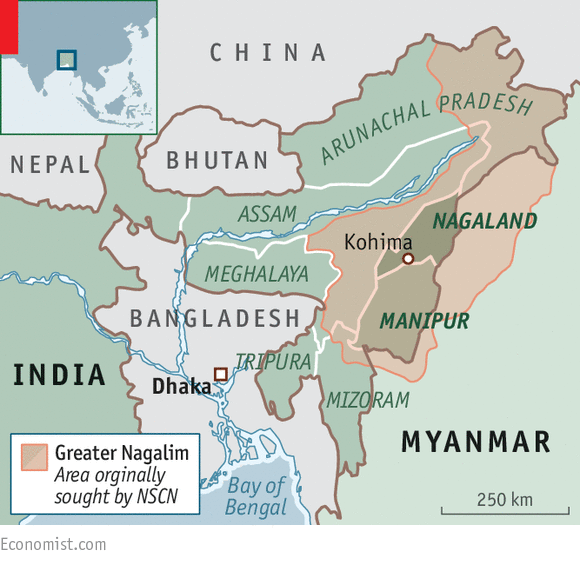Context:
The Isak-Muivah faction of the National Socialist Council of Nagalim (NSCN I-M) has called for third-party intervention to resolve its protracted political conflict with the Indian government. Citing betrayal over the 2015 Framework Agreement, the group has threatened to resume armed resistance if their demand for mediation is rejected. NSCN (I-M) accuses the Centre of failing to fulfill commitments, notably the recognition of a separate Naga flag and constitution, which they argue are crucial for acknowledging the Naga people’s distinct history and “shared sovereignty.”
Relevance:
GS II: Polity and Governance
Dimensions of the Article:
- Who are the Nagas and what is the Naga Issue?
- Peace Initiatives with the Naga
- Issues
- NSCN-IM
- NSCN-IM stand and the deadlock
Who are the Nagas and what is the Naga Issue?
- The Nagas are not a single tribe, but an ethnic community, belonging to Indo-Mongoloid Family, that comprises several tribes who live in the state of Nagaland and its neighbourhood.
- There are nineteen major Naga tribes, namely, Aos, Angamis, Changs, Chakesang, Kabuis, Kacharis, Khain-Mangas, Konyaks, Kukis, Lothas (Lothas), Maos, Mikirs, Phoms, Rengmas, Sangtams, Semas, Tankhuls, Yamchumgar and Zeeliang.
- The key demand of Naga groups has been a Greater Nagalim (sovereign statehood) i.e., redrawing of boundaries to bring all Naga-inhabited areas in the Northeast under one administrative umbrella.
- The Naga inhabited areas include various parts of Arunachal Pradesh, Manipur, Assam and Myanmar.
- The demand also includes the separate Naga Yezabo (Constitution) and Naga national flag.

Peace Initiatives with the Naga
- Shillong Accord (1975): A peace accord was signed in Shillong in which the NNC leadership agreed to give up arms. However, several leaders refused to accept the agreement, which led to the split of NNC.
- Ceasefire Agreement (1997): The NSCN-IM signed a ceasefire agreement with the government to stop attacks on Indian armed forces. In return, the government would stop all counter-insurgency offensive operations.
- Framework Agreement (2015): In this agreement, the Government of India recognised the unique history, culture and position of the Nagas and their sentiments and aspirations. The NSCN also appreciated the Indian political system and governance. However, the details of the agreement are yet to be released by the government.
- Recently, the State government decided to prepare the Register of Indigenous Inhabitants of Nagaland but later due to pressure from various fractions, the decision was put on hold.
Issues:
- The 2015 agreement apparently made the peace process inclusive but it created suspicion about the central government exploiting divisions within the Nagas on tribal and geopolitical lines.
- The issue of integration of contiguous Naga-inhabited areas of Manipur, Assam and Arunachal Pradesh in view of the demand for territorial unification of ‘Greater Nagalim’ will trigger violent clashes in the different affected states.
- Another major hindrance to the peace process in Nagaland is the existence of more than one organisation, each claiming to be representative of the Nagas.
NSCN-IM
- The Isaak Muivah faction of the National Socialist Council of Nagaland (IM), one of the largest Naga groups fighting for an independent Naga homeland.
- They have been engaged in guerrilla warfare against successive Indian administrations since the 1950s.
- One of the main demands of NSCN-IM has been the creation of a sovereign Naga territory that includes Naga-inhabited parts of neighbouring states like Manipur, Assam and Arunachal Pradesh as well as a portion of Burma across the international border, and leaders from those states have long been wary of any accord that would allow the annexation of parts of their land.
- Lack of infrastructure development in the region is one of the perceived reasons for the decades’ long insurgency.
- In 2015, NSCN-IM had entered into an historic Peace Accord (Framework Agreement) with Union government to bring lasting peace in Nagaland.
NSCN-IM stand and the deadlock
- The Naga talks have hit the deadlock since early 2020 as the National Socialist Council of Nagaland-(Isak Muivah) (NSCN-IM) leader has refused to hold any dialogue with interlocutor and Nagaland Governor R.N Ravi.
- The Governor’s letter to the Nagaland Chief Minister saying “over half a dozen organized armed gangs were brazenly running their respective ‘so called governments’ challenging the legitimacy of the State government” had caused the situation to worsen.
- There was also an order asking government officials to declare if their family members or relatives are members of any “underground organisation.”
- NSCN-IM signed a ceasefire agreement with the Centre in 2001, hence they took offense with the “organized armed gangs” view.
- And also given that in a tribal set-up most people are related to each other, asking government officials to declare regarding their family members was seen as insensitive.
- Following the failure of the breakdown of communication between the NSCN-IM and the Nagaland Governor, the Union Home Minister deputed a team of Intelligence Bureau officials to continue the discussions with the NSCN-IM.
-Source: Indian Express




